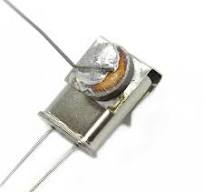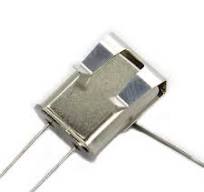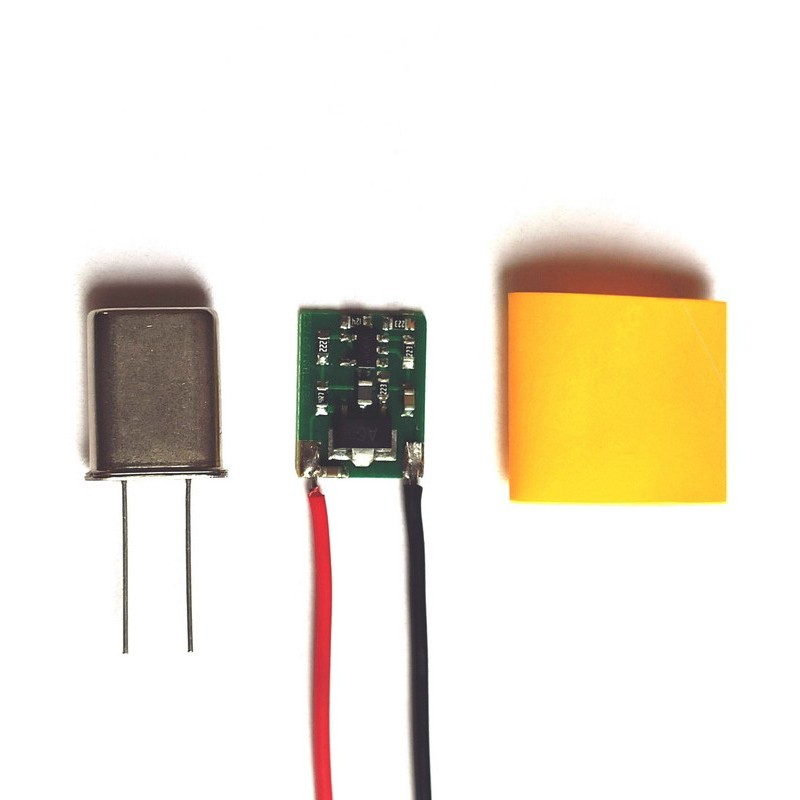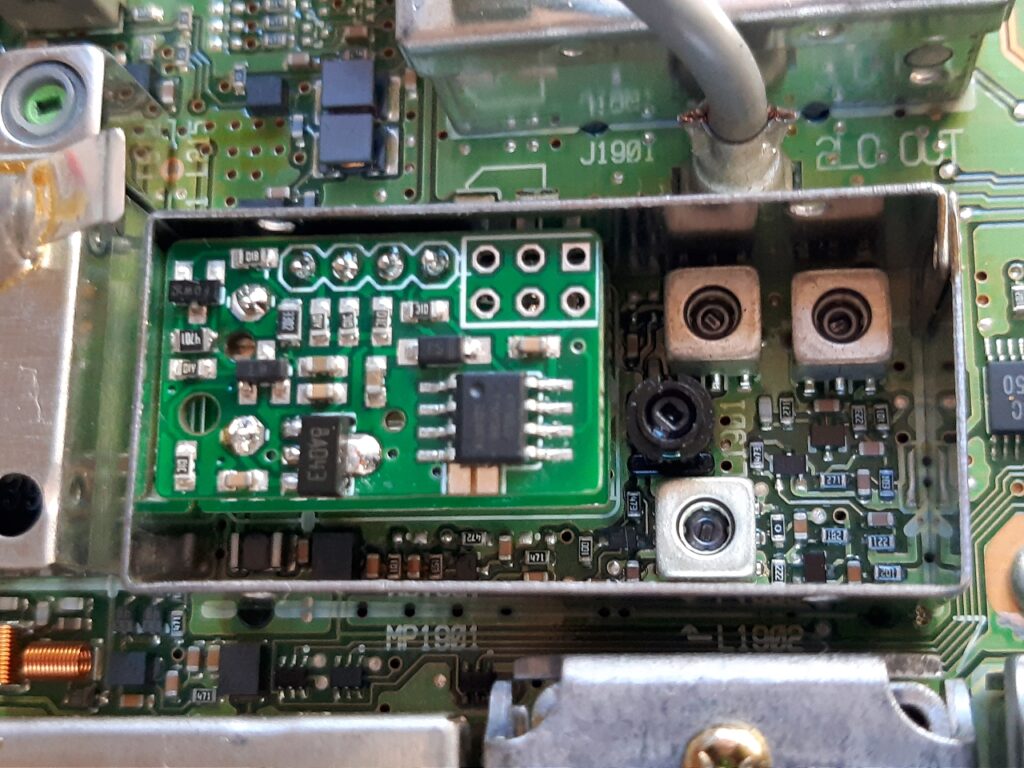IC-7400 Modifications Revisited
@ May 2025
I have had an Icom IC-7400 for many years but the increasing use of it for digital modes means that actual frequency stability (ie drift with temperature) is of greater importance. For instance, Icom specs indicate a freqency drift of about 180Hz at 144MHz is typical and/or expected. That is nowhere near satisfactory for MSK144 use on 144MHz where even 50Hz off-frequency can result in a no-go QSO state.
The 32MHz reference crystal in these radios (and many older radios) is in just a normal-ish crystal oscillator circuit and uses a relatively mid-stability HC-49 style crystal unit.
The actual specs for the CR337 crystal are unknown - Icom does not release that info and neither does it appear in the parts list. It basically just says CR-337, 32.000MHz. No aging or temperature stability values to work to. Or crystal mode : parallel or series. Or capacity if parallel - 30pF ?? Icom did originally offer a CR338 unit option with +/- 0.5PPM rating, and that is basically the equivalent of what was done here. No longer available from any sources I could find.
The ideal is to GPS lock the reference frequency but reasonable accuracy and stability can be achieved by fitting a crystal heater unit directly to the crystal case, allowing it to warm up to temperature and then re-setting the frequency. Minikits (here in VK-land) has two heater units available at present HEATER-HC49-40C and HEATER-HC49-60C (both same price and under $AUD10). There may also be some of the older Murata BG330N heater units around - maybe the option of https://janilab.hu/index.php?route=product/product&language=en-gb&product_id=64 at $USD20 plus shipping. For the really ardent enthusiast, Kuhne Electronic has available Precision crystal heater 40° QH40A, at about 93Euros plus delivery.
{https://shop.kuhne-electronic.com/kuhne/en/shop/zubehoer/quarzheizer/2+x+Precision+crystal+heater+40%C2%B0+QH40A/?card=1965}
Also contemplate the "CRuni-NG TCXO synthesizer for ICOM transceivers" ( see http://www.iw3aut.altervista.org/wordpress/?page_id=2030 ) as a drop-in replacement option equivalent to the CR338. Available via https://www.rfsystem.it/shop/product_info.php?cPath=28&products_id=77 around 83Euros ( @ May 2025).
----------------------------------------------------------------------------
Minikits HEATER-HC49-40C and HEATER-HC49-60C (Images from Minikits web site)
----------------------------------------------------------------------------
JaniLab heater option (Image JaniLab web site)
----------------------------------------------------------------------------
CRuni-NG TCXO synthesizer, as fitted in an IC-7400/IC-746Pro
----------------------------------------------------------------------------
I am well aware that the crystal used with a heater should be rated for a temperature of 40, 50 or 60 degrees Centigrade but my thoughts were that I could always replace the crystal itself if it failed due to the heating. Yet another option is/was to use the likes of an Arduino with a SIS5351 as a synthesiser to inject at 32.000 MHz and use a 10MHz TCXO as a reference for that. If I needed to.
This modification will NOT provide GPSDO-like frequency stability but will improve it so that it might drift plus or minus 10 Hz instead of plus or minus 100 to 200 Hz at 144 MHz!
My junkbox contained 3 x Murata BG330N heaters from the days when I was REALLY into microwave and bought several units - so that gave me a viable heater unit that just clipped onto the HC-49 referece oscillator crystal. These run from around 5 volts to 12 volts and are a posistor - a positive coefficient thermistor. When voltage is applied, the device will rise in temperature but once the knee temp is reached, they do not get any hotter. The current is automatically reduced and the temperature remains fairly constant. The best idea is to run the applied voltage continuously so it does not get a chance to cool down. Make sure that the ground side of the heater is taken DIRECTLY to the tinplate side by a short wire - the original shows frequency change effects by even placing a finger on the crystal itself.
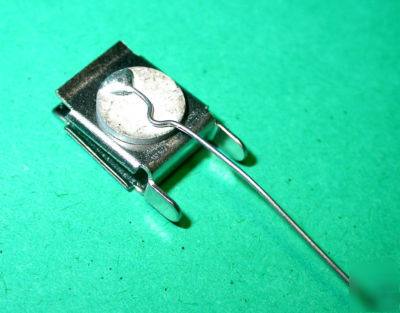
The BG330N device that I used in my mod..
In my case I elected to utilise an 8V positve 3-terminal regulator to provide a constant voltage BUT then provided the input voltage from 2 sources via silicon diodes (thus isolating the power sources from each other), one is internal in the radio and taken from terminal EP5, which is the radio-side of the DC input filtering. That way when the power supply is applied, there is power to the regulator - even if the radio is actually powered off.
The second source is an external +12V fed from a small external DC power pack (sometimes called wall-warts) and that one is powered on 24x7. The current drain is less than 100mA at 12V, so about 1.5 watts power usage, and even a small unit will suffice.
One thing that becomes immediately obvious once one of these heaters is fitted and powered is the shift in frequency of the radio - in the IC-7400 it went high by hundreds of Hz as the heater warmed. Method of measurement was using WSJT-X on FT8 and observing a stable reference frequency. The 14th harmonic of my GPSDO's 10MHz output was observed by setting the radio to 139.999000 MHz, to effect a 1000Hz audio tone. Of course, any 'good' high-stability signal source will suffice but the higher the frequency (within the range of the receiver) the more accurately the frequency can be set. One of the GPS-based 6 or 2 metre beacons is a suitable alternative, but remember to set the receiver frequency for that 1000Hz tone.
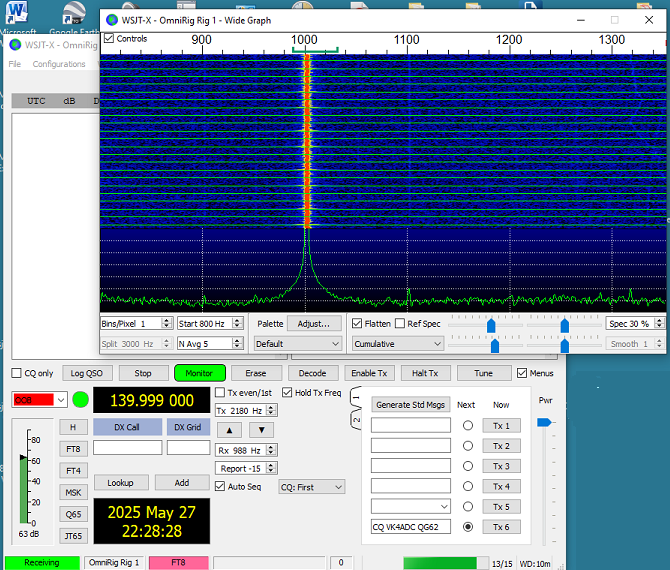
A hint : set the FT8 WSJT-X graph display to '1 pixel per bin' and a 'start frequency' of 800Hz. That way the observed tone is towards the centre of display and frequency 'tick-marks' are at 20Hz points, making it easy to shift the reference very close to frequency. Make sure there is not any obvious drift in the on-screen tone before you accept that the crystal unit is up-to-temperature and that calibration could proceed. And don't forget to reset the WSJT-X settings back to 5 or 6 bins per pixel and the start frequency back to 100 or 200 Hz later on - else you will wonder why the display on FT8 looks weird.
There was enough room in the oscillator compartment to push in some small trimmed polystyrene (/Koolite) blocks around the crystal plus heater to provide extra thermal stability and another piece was added across the entire compartment. After all, you do not want to (necessarily) heat the whole compartment !
Here is another suggestion while we have the 7400 covers off ...
The IC-7400 has a rear-access trimpot (R1032) to set the reference frequency but it is somewhat 'touchy' to get precise frequency setting. While I had the unit open to fit the heater and the cover over the RF unit removed, I added a small figure-8 cable wired across R1033, the lower resistor in the frequncy-set circuitry. A 20K 10-turn pot was added via the fig-8 to allow finer frequency setting.
Another tip : set the 20K pot to approximate centre range before using R1032 to set the 1000Hz tone as accurately as you can achieve. Final fine-frequency adjustment is then possible via the 20K pot.
Lastly...
The changes (only exactly relevant to the IC-7400 and IC-746Pro) are as shown in the following diagram. The same concepts are applicable to many other models, both Icom and non-Icom.
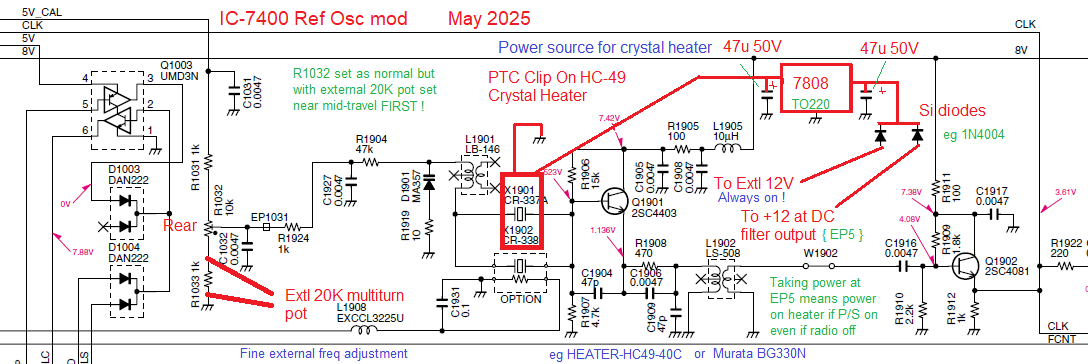
You might wonder why bother on such an old radio ?
The IC-7400 is a terrific workhorse so why not !!

